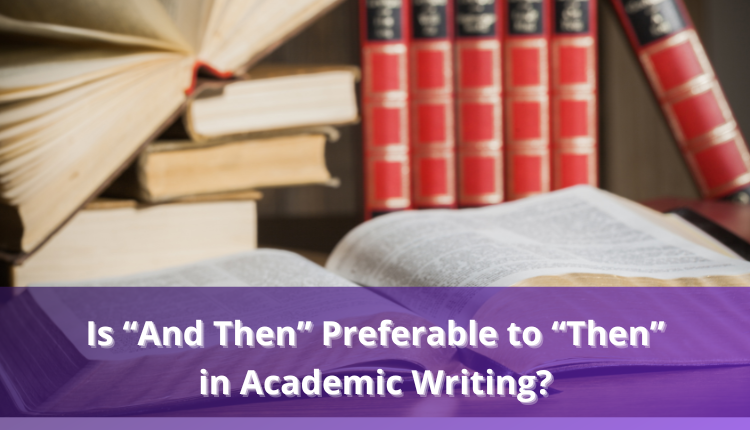Academic writing is always a challenge, even for experienced researchers and scholars. One reason for this is that much academic writing is performed in English, the global language.
Because English is the global language, there are variations all over the world, and conventions on what is “right” and what is “wrong” can vary depending on country, institution, journal, preferred writing or citation style, and other such factors.
Like all languages, phrasing that was considered “wrong” in the past can become “right” over time if enough people use it repeatedly. At the same time, language considered “right” in the past can become less commonly used and eventually sound “wrong.”
One such example of this is the use of the word “then.” Is it a connecting word, or does it only tell us the order in which something happened? Is it formal enough to use “then” or should we use “and then” in academic writing? Are there some situations where one is preferable to the other? Let’s take a look.
Table of Content:
What does “Then” Mean, Anyway?
While this may seem like a simple question, the answer, in fact, is more complicated than you think. First of all, the word “then” is an adverb. An adverb is a word that modifies an adjective, verb, or other adverb to express the extent or degree of something. An adverb can also communicate place or time. When used as an adverb, “then” can have multiple meanings, including:
- In addition
- Next
- In that case
Let’s look at a few examples of “then” with each of the meanings above.
“Then” meaning “in addition”:
I have to finish writing this blog tonight, then I have to translate the article on COVID-19-related exercise intolerance.
“Then” meaning “next”:
First the clouds began to gather, then it started to rain.
“Then” meaning “in that case”:
If the cafe doesn’t have soy milk, then just get me a black coffee.
“Then” can also be used as a noun, meaning “at that time”:
The murder happened at 3pm on Tuesday, June 7. Where were you then?
“Then” vs. “And Then”
Let’s consider the following sentence.
I dosed the rats with linagliptin, then noted their A1-C levels in the chart.
In this case, “then” is used to mean “next” or “after that.” Instead of an adverb or noun, “then” is being used as in place of a coordinating conjunction. A coordinating conjunction is a word that connects two ideas or phrases of equal status. The words “and,” “but,” and “or” are all examples of coordinating conjunctions that we are familiar with.
You have probably seen the word “then” used in this way rather frequently. For example:
“Patients were given the drug ozempic for three weeks, then weighed.”
“First melt butter in a pan, then add garlic and onions.”
“The article was edited, then published.”
In fact, all of these uses of “then” can be considered technically incorrect, since “then” is not actually a coordinating conjunction. While its use as a coordinating conjunction has become common, the addition of “and” to all of these sentences will make them clearer and sound more natural to some native English speakers.
“Patients were given the drug ozempic for three weeks, and then weighed.”
“First melt butter in a pan, and then add garlic and onions.”
“The article was edited, and then published.”
If you are writing an academic article and would like to achieve maximum clarity and accuracy in your writing, this editor advises you to use “and then” instead of “then” to mean “next” or “after that.” However, if you are using “then” as an adverb or noun, there is no need to include “and,” although you can if you wish.
One important thing to note is that there is a comma preceding the word “then” in all of the examples above. While it is true that you can use “then” or “and then” in the examples above, if you do not include the comma, you must use “and.” For example:
CORRECT: “The article was edited, and then published.”
CORRECT: “The article was edited, then published.”
INCORRECT: “The article was edited then published.”
CORRECT: “The article was edited and then published.”
Quiz: Should You Use “Then” or “And Then”?
Still not sure when to use “then” and when to use “and then”? Take our practice quiz below to practice identifying when to use “then” and when to add “and.” The answers are given below.
- The car was washed then dried and polished.
- If you’re going to the concert later, I’ll see you then.
- If patients are unresponsive to linagliptin, then try metformin.
- When writing an academic article, you need to check for typos then proofread.
- The conference happened last week, but I wasn’t available to attend then.
- If inflation increases, then central banks raise interest rates.
- If you fail your thesis defense then you will be expelled from university.
Did you figure it out? Check your answers below.
- The car was washed, and then dried and polished.
- No change is needed in this sentence.
- No change is needed in this sentence.
- When writing an academic article, you need to check for typos, and then proofread.
- No change is needed in this sentence.
- No change is needed in this sentence.
- No change is needed in this sentence, although a comma can be added before “then”.
Remember, the goal of all writing, especially academic writing, is to convey your ideas in a clear and concise way. It is better to err on the side of clarity and write “and then” when “then” means “next” or “after that.”
While you can just write “then,” you must include a comma between the preceding word and “then.” When in doubt, you can always consult an online spelling or grammar checker like Trinka, which will check your academic writing to make sure it is clear and error-free.

